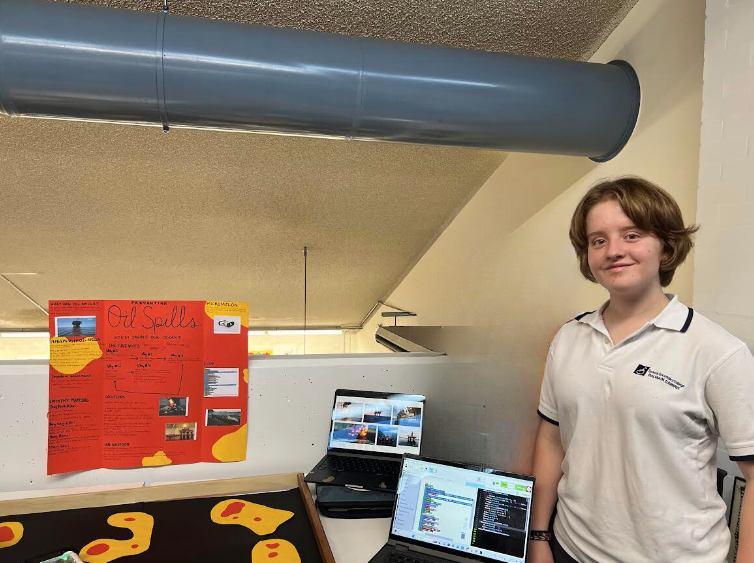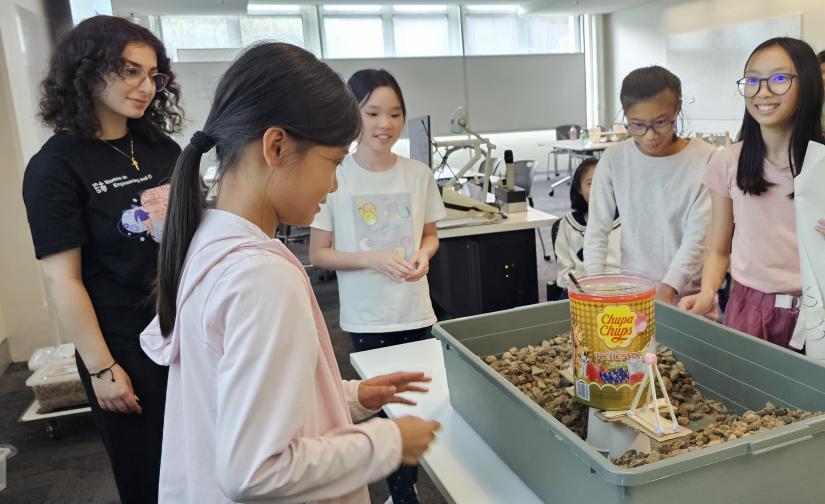Young girls showing how STEM can change the world
Have you ever seen a robot on the ocean floor? It may seem odd to picture, but according to 14-year-old Maddie Blanch and Arielle Bor from Sydney Secondary College Balmain Campus, it could be the way forward to keep our oceans clean. The girls were tasked with finding a solution to this real-world problem as part of UTS’s Women in Engineering and IT’s (WiEIT) STEM x Outreach program – an initiative aimed at inspiring young women to consider a career in STEM (Science, Technology, Engineering and Mathematics).
Women have been historically underrepresented in STEM.
The Australian Government’s ‘STEM Equity Monitor’ (2023 update) shows girls only make up a quarter of enrolments in year 12 information technology, physics, and engineering classes. When it comes to higher education, women make up 37% of enrolments in university STEM courses, and just 17% of VET STEM enrolments.
‘I think girls aren’t interested in engineering and IT because these are currently male-dominated fields. We don’t see many women in engineering and IT jobs, and so don’t see it as an option,’ said Arielle.
This sentiment was echoed by classmate Maddie, who also pointed out that men tend to receive more recognition in this space.

Maddie Blanch from Sydney Secondary College Balmain Campus.
‘I think that the reason why more girls aren't really interested in engineering and similar subjects is because we only ever learn about men doing it, and the prizes and recognition which men have been awarded.
‘We hardly ever see women in the field unless it’s in research or other minor roles. The curriculum doesn't really include the amazing women that have made their careers in these fields,’ she said.
Stereotypes, bias, a lack of role models and understanding of STEM career options, disengagement from STEM education, and family and cultural expectations have been identified as key barriers to participation for girls in primary and secondary education in these areas.
The WiEIT STEM x Outreach program sets out to address all six barriers by providing meaningful experiences for girls, teachers and families to engage with engineering and IT.
The two key arms of the program – which has been running since 2019 – is STEM x Play, aimed at Year 5 and 6 students, and STEM x Impact, aimed at early high school students.
‘We target late primary and early high school aged girls because that’s the time they start to think about what they like and don’t like, and what they may want to pursue in the future,’ said Marco Angelini, WEIT Program Outreach Coordinator.
‘It’s in this period that they’re really forming their identities as learners, and it’s a prime time for us to show them they can have a career in STEM.’
Marco says girls and young women are often discouraged or steered away from pursuing a career in engineering or IT.
‘The best part of our project is that we’re able to engage with families, teachers, career professionals and whole school communities over time, which allows us to address culture change and the messages that are out there in a long-term way,’ he says.
The STEM x Impact initiative – which Arielle and Maddie took part in – is structured around the five stages of design thinking:
- Empathise
- Define the problem
- Ideate
- Prototype
- Test

Students visiting the UTS campus for the Faculty of Engineering and IT's STEM x Holiday workshops.
The initiative also helps students improve their 21st century skills.
‘In 2024, the students were challenged to think of ways to “keep the ocean clean” by using robotic arms,’ says Marco.
‘As part of the project, students get to choose the problem they want to solve, and then design the solution using the technology available to them in the workshop. They go through the ideation process, before moving on to prototyping and testing, and eventually presenting and showcasing the final product.
‘It really tests their teamwork, critical thinking, and problem-solving skills, which is not only handy for curriculum, but also for STEM disciplines,’ he said.
For Arielle, the program wasn’t just beneficial for learning news skills, but also because it gave her access to new and exciting tools.
‘My favourite part of the program was learning how to use technologies that our school doesn’t have. We have had robots, drones, robotic arms and Arduinos that have been borrowed from UTS,’ says Arielle.
‘By the end of the program my team and I had a robot that could navigate a surface without bumping into anything by using ultrasonic sensors. In the context of the ocean, this means it could avoid bumping into coral and crown-of-thorns starfish while it tries to collect rubbish,’ she says.
For Maddie, the program also helped her to learn about the design thinking process, including how to empathise and define the problem, ideate, prototype and test a solution, and to see how her work could positively impact society.
‘My favourite parts were learning to code the Micromelons and getting them to move around to do the things we wanted them to do. It allowed us to visualise how the technology could be helpful and practical in a real-world context.
‘I also learnt a lot about the design thinking process and how it helps us make our experiments or products more personalised and usable for the people it is intended for,’ says Maddie
Both girls are currently taking STEM electives and are involved in the school’s Girls STEM Club.
‘My school is very proactive in encouraging girls in STEM and this is where I’ve found out about the UTS programs. It’s a very encouraging environment, and there are heaps of people willing to support us,’ says Maddie.
When asked how they think we could encourage more women and girls to pursue STEM, both girls’ answers very much aligned with the saying: ‘you can’t be what you can’t see’.
‘Having more women working as engineers or in STEM fields will show younger girls that this is an option for them. Another way is by having more articles and photos in the media promoting women in STEM. We need to also keep challenging gender stereotypes so younger girls don’t feel restricted to take part in STEM activities or careers because of society’s stereotypes,’ says Arielle.
‘Teach them about the women that are professionals in these fields. Show them women who do these things. Get them interested. Give them women they can look up to, programs they can be a part of, and show them what the technology can do so that they can be part of expanding these fields of research,’ echoed Maddie.
Student showcase as part of the UTS Faculty of Engineering and IT’s STEM x Play primary school program.
The WiEIT STEM x Program is currently run in 30–35 schools across NSW and is financially supported by Cognizant Australia.
While WiEIT acknowledges the importance of delivering this program, they hope that we’ll one day reach a point where we no longer need it.
‘Although we love the work that we are doing now, we look forward to the time that we don't need to have these kinds of outreach programs to encourage young women into this field. It’ll just be normal. I think that's the ideal that we are very much working towards,’ says Faezeh Karimi, Deputy Director, WiEIT.
UTS has received two Cygnet Awards from Science in Australia Gender Equity for efforts in supporting women and girls in STEMM. Part of the Athena Swan accreditation pathway, Cygnet Awards recognise successful initiatives aimed at reducing and eliminating barriers to gender equity.
UTS’s Cygnet Awards were for: Supporting career progression for Higher Degree Research (HDR) students in the Faculty of Engineering and IT; and Building the pipeline through outreach to attract women to Engineering and IT in early education.
Find out more about UTS’s work in the gender equity space, as well as the STEM x Outreach program.
